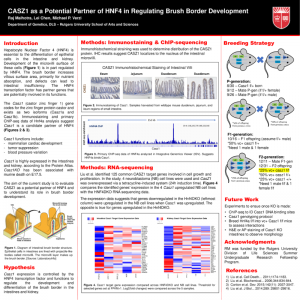Malhotra, Raj: CASZ1 as a Potential Partner of HNF4 in Regulating Brush Border Development
Title: CASZ1 as a Potential Partner of HNF4 in Regulating Brush Border Development
Name: Raj Malhotra
Major: Genetics
School affiliation: School of Arts and Sciences
Programs: Division of Life Sciences Summer Undergraduate Research Fellowship (DLS-SURF)
Other contributors: Raj Malhotra, Lei Chen, Michael P. Verzi
Abstract: Hepatocyte Nuclear Factor 4 (HNF4) is essential to the differentiation of epithelial cells in the intestine and kidney. Development of the microvilli surface of these cells (Figure 1) is in part regulated by HNF4. The brush border increases villous surface area, primarily for nutrient absorption, and defects can lead to intestinal insufficiency. The HNF4 transcription factor has partner genes that are potentially involved in its functions. The Casz1 (castor zinc finger 1) gene codes for the zinc finger protein castor and exists as two isoforms (Casz1a and Casz1b). Immunostaining and binding DNA motif analysis suggest Casz1 is a candidate partner of HNF4. Casz1 functions are involved in mammalian cardiac development, tumor suppression, and blood pressure variation. Casz1 is highly expressed in the intestines and kidney, according to the Protein Atlas. Casz1KO has been associated with murine death on E17.5. The aim of the current study is to evaluate CASZ1 as a potential partner of HNF4 and to understand its role in brush border development.
